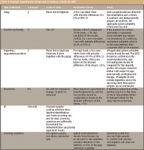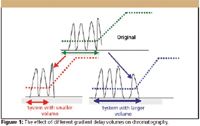Analytical Method Transfer
LCGC North America
November 2006. The objective of a formal method transfer is to ensure that the receiving laboratory is well trained, qualified to run the method in question, and gets the same results - within experimental error - as the initiating laboratory. The development and validation of robust methods and strict adherence to well documented standard operating procedures is the best way to ensure the ultimate success of the method. This installment of "Validation Viewpoint" examines the analytical method transfer process, including protocol, documentation, and some possible chromatographic pitfalls to avoid.
In a regulated environment, it is rare for the laboratory that develops and validates a method to perform routine sample testing. Instead, once developed and validated (in the originator, or "sending" laboratory), methods commonly are transferred to another laboratory (the "receiving" laboratory) for implementation. However, the receiving laboratory must still be able to get the same results, within experimental error, as the originating laboratory. The process that establishes documented evidence that the analytical method works as well in the receiving laboratory as in the originator's laboratory, or the transferring laboratory, is called analytical method transfer (AMT). The topic of AMT has been addressed by both the American Association of Pharmaceutical Scientists (AAPS, in collaboration with the FDA, EU regulatory authorities) and the Pharmaceutical Research and Manufacturers of America (PhRMA) (1–3). The PhRMA activities resulted in what is referred to as an acceptable analytical practice (AAP) document that serves as a suitable first step guidance document for AMT (3). In their various publications, both AAPS and PhRMA have described the AMT process in some detail. This column summarizes some of the available guidance and adds a few additional thoughts concerning potential chromatographic pitfalls. However, as always, we encourage readers to consult these and other references for more information (4–8). In essence, the AMT process is what qualifies a laboratory to use an analytical testing procedure, and regulators want documented proof that this process was completed successfully. Only then can the receiving laboratory obtain good manufacturing practices (GMP) "reportable data" from their laboratory results. A typical AMT would take place between a research group that developed the method and a quality control group responsible for releasing finished product, although anytime information moves from one group to another (for example, to a contract laboratory) proper AMT should be observed. Both the originator and the receiving laboratories have certain responsibilities and must make certain provisions in the AMT process; they are listed in Table I.

Michael E. Swartz
Before initiating AMT, there are a few pretransfer activities that must take place. If not previously involved with the method, the receiving laboratory should have an opportunity to review the method before the transfer, and to actually run the method to identify any potential issues that might need to be resolved before finalizing the transfer protocol. The originator should provide the receiving laboratory with all of the validation results, including robustness study results, as well as documented training.

Ira S. Krull
Analytical Method Transfer Options
Like many things in life, a little up-front investment prevents a multitude of problems later on. The foundation of a successful AMT is a properly developed and validated method or procedure, and a good robustness study is certainly a development and validation cornerstone (9–11). The AMT process needs to involve more than the receiving laboratory obtaining expected results from a representative sample, because a single test is no indication of how a method will perform over time. A single test also does not generate the data necessary to perform proper statistical evaluations, and compensating errors also could be masked. A formal AMT is not always necessary, however. Compendia methods (for example, Karl Fisher, residue on ignition), in-process tests, or research methods do not require a formal transfer. In the latter two cases, a system suitability test is employed as the basis for the transfer.
There are several different ways, or options for AMT. These include comparative testing, complete or partial method validation or revalidation, covalidation between the two laboratories, and the omission of a formal transfer, sometimes called a transfer waiver. The choice of which option to use depends upon the stage of development the method is being used in (early or late stage), the type of method (that is, compendia versus noncompendia, simple or complex), and the experience and capabilities of the laboratory personnel.

Table I: Sending laboratory responsibilities and receiving laboratory provisions. Both laboratories are responsible for issuing the final report.
Comparative Testing
Comparative testing is the most common AMT option used. It is accomplished when two or more laboratories perform a preapproved protocol that details the criteria used to determine whether or not the receiving laboratory is qualified to use the method being transferred. The data resulting from the joint exercise are compared against a set of predetermined acceptance criteria. Comparative testing also can be used in other postapproval situations involving additional manufacturing sites or contract laboratories. In general, comparative testing is most often used for late stage methods and the transfer of more complex methods.
Covalidation Between Laboratories
Traditionally, a validated method is a prerequisite to AMT. However, another option for AMT is to involve the receiving laboratory from the beginning in the actual validation of the method to be transferred. By completing a covalidation study, the receiving laboratory is considered qualified to perform the method for release testing. To perform this transfer option, the receiving laboratory must be involved in identifying the intermediate precision (formerly called ruggedness) validation parameters to be evaluated and the experimental design (11). By including data from all laboratories involved in the study, it is possible to have the validation report stand as proof of AMT.
Method Validation and Revalidation
A third option for AMT is method validation and revalidation. This option involves the receiving laboratory repeating some or all of the originating laboratories validation experiments. As discussed previously, by completing any type of validation study, the receiving laboratory is considered qualified to perform routine release testing.
Transfer Waiver
In addition to the times when a formal AMT is not needed (for example, compendia methods) certain other situations also might warrant omitting a formal AMT. They include the following situations:
- The receiving laboratory is already testing the product and is thoroughly familiar with the procedures.
- A method or procedure for a comparable dosage form relative to the existing product.
- The analytical method (or one very similar) is already in use.
- A new method that involves changes that do not significantly alter the use of the method.
- The personnel accompany the transfer of the method from one laboratory to another.
When a transfer waiver is indicated, the receiving laboratory can use the method without generating any comparative data. However, the reasons for the waiver must be documented.
The Elements of AMT
Many interrelated components are necessary to achieve a successful AMT. As in any validation process, documentation is pervasive; both for the process and the results. Starting with a protocol, and ending with a transfer report, everything must be documented for compliance purposes.
Preapproved Test Plan Protocol
Before implementing an AMT, an approved document must be in place that describes both the general transfer process, as well as the acceptance criteria. This document usually takes the form of a standard operating procedure (SOP) that describes the details of the AMT protocol or test plan specific to the product and method. This document should define clearly the scope and objective of the AMT, all of the respective laboratories responsibilities, list all the methods that will be transferred, and a rationale for any methods not included (that is, the transfer waiver).
It also should include the selection of materials and samples to be used in the AMT. Representative, homogeneous samples should be used that are identical for both laboratories. Selection of proper materials and samples is very important; usually pre-GMP materials or a "control lot" are chosen so that an out-of-specification (OOS) investigation is not triggered. Remember, the purpose of the method transfer is to assess method performance, not changes in samples or matrix. The protocol also should include certificates of analysis for any samples and reference materials used.
Instrumentation and associated parameters also should be described. A best-case scenario would have each laboratory using common instrumentation; if this is not the case, and it rarely is, then the originator should consider running the method on instrumentation common to the receiving laboratory to identify any potential issues before a formal AMT. Intermediate precision validation studies also commonly take instrument differences into account.
The protocol also should include a description of procedures, requirements and their rationale, as well as acceptance criteria as outlined later. Templates for protocols of different method types are included in the International Society for Pharmaceutical Engineering (ISPE) book as appendices and can be consulted for more details (1).
Description of Method and Test Procedures
The method description should include not just the mechanics of performing the method, but also validation data, and any idiosyncrasies in the method. Any precautions that must be taken to ensure successful results also should be included in the method description. The method should be written in a way as to ensure only one possible interpretation, for example, v/v if volume measurements are made. Clear equations and calculations, if appropriate, should be specified.
Description and Rationale of Test Requirements
Specific information on the number of lots, replicates, and injections, amongst other parameters, also should be included in the method description, as well as the rationale for how each parameter was chosen. This section also should describe any system suitability parameters established for the method.
Acceptance Criteria
The acceptance criteria stipulate how the results will be evaluated. Because statistical evaluations are usually employed, clear instructions on the number of batches and replicates are needed. It is common for simple statistics such as the mean and standard deviation from repeated use of the method in the originating–transferring laboratory to be used for acceptance criteria. More sophisticated statistics, like the F-test, or t-test, also are applied commonly. The proper use of statistics can provide an unbiased objective view of the comparison results of the transfer, and any approach used should be a part of the overall protocol documentation. While a comprehensive statistical discussion is outside the scope of this column, several good references are available for more detail (13–15). A wealth of information also can be found on the internet simply by "Googling" the term of interest or for statistic information in general.
Because specifications are completely method, instrument, sample, etc, dependant, hard and fast specifications are not listed in the PhRMA guidance. However, a partial summary of the AAPS publication's list of recommended experimental design and acceptance criteria is presented in Table II.

Table II: Example experimental design and acceptance criteria for AMT
Documentation of Results: The AMT Report
Once completed, the results are summarized in an AMT Report. The report certifies that the acceptance criteria were met, and that the receiving laboratories are trained fully and qualified to run the method. In addition to summarizing all of the experiments performed and the results obtained, it also should list all of the instrumentation used in the transfer. Like any laboratory exercise, an important aspect of the AMT report are observations made while performing the method and also should be included. Observations in the form of feedback can be used to further optimize a method, or to address special concerns that might not have been anticipated by the originating laboratory. Of course, sometimes the receiving laboratory might not meet the acceptance criteria in the AMT protocol. When this situation arises, they should be addressed by a policy that dictates how the situation should be handled. An investigation should be initiated and documented in the summary report, and any corrective action taken justified.
Potential AMT Pitfalls
Many of the common pitfalls encountered during AMT can be prevented with a little up-front work. It cannot be stressed enough that the robustness studies performed during late method development or early method validation play a critical roll in the success of AMT. During the robustness studies, many of the critical elements already might have been identified and noted as a precautionary statement in the method. Intermediate precision validation studies also can serve to identify potential AMT issues. By anticipating that, for example, instruments, experience and training, and procedure interpretations can all differ from laboratory to laboratory, many of the common pitfalls can be avoided.
Instrument Considerations
Many adverse effects encountered during AMT can be traced to the instrument. Injectors differ in design and cycle time, detectors can have different filters, time constants, wavelength accuracy and parameters such as resolution and wavelength range (if appropriate), and pumps deliver solvents in different ways (for example, low- versus high-pressure mixing systems). One of the more significant issues involves gradient separations that are in much more common use today than in times past. When transferring gradient methods between different systems, gradient delay volume must be taken into account, otherwise the situation illustrated in Figure 1 can cause significant problems. The top chromatogram in Figure 1 is a representation of the original method. Note that the fourth peak is eluted at the start of the gradient, the others in the isocratic segment. The bottom left chromatogram could result upon transferring the method to a system with a smaller gradient delay volume. Due to the smaller volume, the gradient reaches the column before the isocratic elution of the third peak, compressing it into the fourth peak. In contrast, the bottom right chromatogram could result upon transferring the method to a system with a larger gradient delay volume, effectively resulting in a longer isocratic hold time. The first three peaks still are eluted as in the original system; the fourth peak, however, is now eluted later.

Figure 1
Because LC systems on the market today can differ by as much as 10× (100 μL to over 1 mL) in system volume, it is often useful to build in an isocratic hold at the beginning of the gradient for delay volume compensation. If the target system has a smaller system volume, an additional isocratic hold is added at the beginning of the gradient. If the target system has a larger system volume, no exact compensation is possible, nor is it necessarily needed. One word of caution: there are many ways to measure system gradient delay volume. Methods involving linear gradients are preferred because step gradients will not take into account proportioning valve volume in low-pressure systems or actual chromatographic conditions (16,17). Extracolumn band broadening from improperly made fittings or longer tubing lengths also can contribute variability.
Column Considerations
Historically, LC columns have been a significant source of variability. However, recently manufacturers vastly have improved reproducibility on both a column-to-column and a batch-to-batch basis by having complete control over the manufacturing process and raw materials. It is now a recommended practice to specify the brand and other details of the column used. If additional columns have been tested and approved for the method, they also should be specified by name. Using the blanket statement "or equivalent" should be avoided at all costs given the variability of columns between manufacturers, even if they are of the same type (for example, C18). The United States Pharmacopeia (USP) is addressing this issue by creating a database that uses chromatographic tests to classify columns according to various parameters (18). When finalized, users will be able to cross reference columns that can be equivalent to the one currently in use.
Column temperature is another source of variability. To achieve the kind of reproducibility demanded by today's separations the days of room temperature or "controlled" room temperature separations are long past. Nowadays columns are thermostated at least a few degrees above the highest room temperature to compensate for both intra- and interlab temperature variability, either with (preferred) or without solvent preheating. The accuracy and precision of the set temperature of column heaters also can vary and therefore also should be considered. Proper column equilibration also should be observed, either before being used for the first time (isocratic mode) or between runs (gradient mode).
General Considerations
There are other sources of variability that can lead to pitfalls. Training can be addressed at any time, but it is not uncommon to train new users of the method before formal AMT. Sometimes despite all the upfront work, errors are still made; either honest mistakes, or errors in procedure that result from method ambiguities. Procedures should be written so that there is only one possible interpretation of how to perform the method, with enough detail so that nothing is left to chance.
Conclusion
The development and validation of robust methods and strict adherence to well documented SOPs is the best way to ensure the ultimate success of the AMT. A proper statistical evaluation of the results of the AMT measured against predetermined acceptance criteria as outlined in the AMT protocol is critical to the process to ensure method success upon implementation in the receiving laboratory.
Michael E. Swartz "Validation Viewpoint" Co-Editor Michael E. Swartz is a Principal Scientist at Waters Corp., Milford, Massachusetts, and a member of LCGC's editorial advisory board.
Ira S. Krull "Validation Viewpoint" Co-Editor Ira S. Krull is an Associate Professor of chemistry at Northeastern University, Boston, Massachusetts, and a member of LCGC's editorial advisory board.
The columnists regret that time constraints prevent them from responding to individual reader queries. However, readers are welcome to submit specific questions and problems, which the columnists may address in future columns. Direct correspondence about this column to "Validation Viewpoint," LCGC, Woodbridge Corporate Plaza, 485 Route 1 South, Building F, First Floor, Iselin, NJ 08830, e-mail lcgcedit@lcgcmag.com
References
(1) ISPE Good Practice Guide: Technology Transfer, (ISPE, Tampa, Florida, 2003).
(2) PhRMA Analytical Research and Development Workshop, Wilmington, Deleware, 20 September, 2000.
(3) S. Scypinski, D. Roberts, M. Oates, and J. Etse, Pharm. Tech., 28(3) 84 (2004).
(4) E. Mcgonigle, "Assay Validation and Interlaboratory Transfer'" in Development and Validation of Analytical Methods, C.M. Riley and T.W. Rosanske, Eds. (Elsevier, New York, 1996), p. 3.
(5) S. Scypinski, "Analytical Method Transfer," in Handbook of Modern Pharmaceutical Analysis, S. Ahuja and S. Scypinski, Eds. (Academic Press, San Diego, California, 2001), p. 485.
(6) A.S, Lister, in Handbook of Pharmaceutical Analysis by HPLC, S. Ahuja and M. Dong, Eds. (Elsevier, New York, 2005), p. 212.
(7) L.R. Snyder, J.J. Kirkland, and J.L. Glajch, chapter 15 in Practical HPLC Method Development (John Wiley and Sons, New York, 1997), p. 685.
(8) J. Etse, Amer. Pharm. Rev. 8(1), 74 (2005).
(9) USP 29, 2006, Chapter 1225, pp. 3050–3053.
(10) International Conference on Harmonization, Harmonized Tripartite Guideline, Validation of Analytical Procedures, Text and Methodology, Q2(R1), November 2005, See www.ICH.org.
(11) M. Swartz and I. Krull, LCGC 24(5), 480 (2006).
(12) M. Swartz, Pharm. Techn. Special Supplement, 12 (June 2006).
(13) J.C. Miller and J.N. Miller, Statistics for Analytical Chemistry (Ellis Horwood Publishers, Chichester, UK, 1986).
(14) NIST/SEMATECH e-Handbook of Statistical Methods, http://www.itl.nist.gov/div898/handbook.
(15) P.C. Meier and R.E. Zund, Statistical Methods in Analytical Chemistry (John Wiley and Sons, New York, 1993).
(16) L.R. Snyder, J.J. Kirkland, and J.L. Glajch, Practical HPLC Method Development (John Wiley and Sons, New York, 1997).
(17) M. Swartz and R. Plumb, unpublished results.
(18) H. Pappa and M. Marques, presentations at USP Annual Scientific Meeting, Denver, 28 September 2006.

Determining Enhanced Sensitivity to Odors due to Anxiety-Associated Chemosignals with GC
May 8th 2025Based on their hypothesis that smelling anxiety chemosignals can, like visual anxiety induction, lead to an increase in odor sensitivity, a joint study between the University of Erlangen-Nuremberg (Erlangen, Germany) and the Fraunhofer Institute for Process Engineering and Packaging (Freising, Germany) combined behavioral experiments, odor profile analysis by a trained panel, and instrumental analysis of odorants (gas chromatography-olfactometry) and volatiles (gas chromatography-mass spectrometry).
Investigating 3D-Printable Stationary Phases in Liquid Chromatography
May 7th 20253D printing technology has potential in chromatography, but a major challenge is developing materials with both high porosity and robust mechanical properties. Recently, scientists compared the separation performances of eight different 3D printable stationary phases.
Detecting Hyper-Fast Chromatographic Peaks Using Ion Mobility Spectrometry
May 6th 2025Ion mobility spectrometers can detect trace compounds quickly, though they can face various issues with detecting certain peaks. University of Hannover scientists created a new system for resolving hyper-fast gas chromatography (GC) peaks.

.png&w=3840&q=75)

.png&w=3840&q=75)



.png&w=3840&q=75)



.png&w=3840&q=75)









